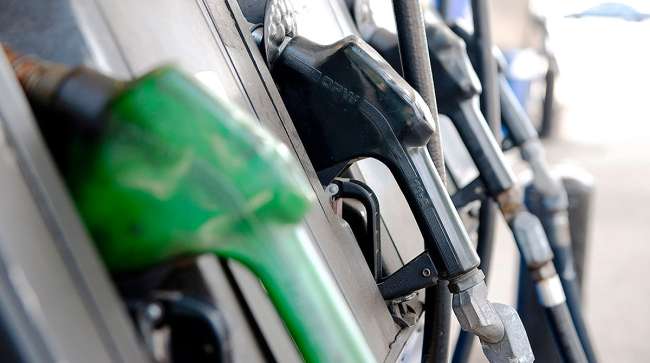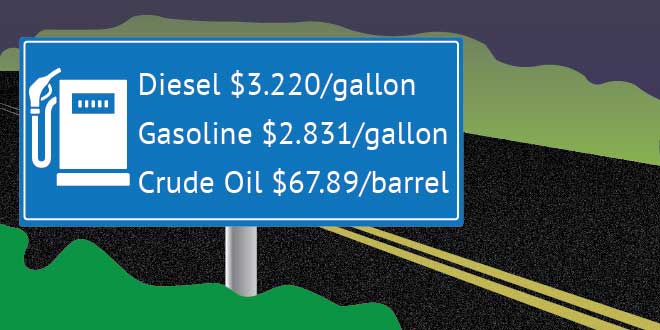Diesel Falls 1.9¢ to $3.220 as Mideast Jitters, Strong Dollar Seesaw Price of Oil

The U.S. average retail price of diesel fell 1.9 cents to $3.220 a gallon while crude prices slipped.
It marked the second straight weekly decline in trucking’s main fuel, which has dropped 2.3 cents a gallon in the period.
Diesel fuel costs 71.3 cents a gallon more than it did a year ago, when the price was $2.507, the Department of Energy said July 23.
Averages fell in all regions, the most being 2.9 cents a gallon in the Midwest, where it was $3.142 a gallon.
The national average price for regular gasoline fell 3.4 cents to $2.831 a gallon, DOE’s Energy Information Administration said. The average is 51.9 cents higher than it was a year ago.
Gasoline prices also fell in all regions.
At the same time, discussions about the most appropriate fuel for heavy-duty trucks continue.

Advocates for biofuel are weighing on blending levels ahead of a deadline for comments likely to fall on Nov. 30, which has been the timeframe over the past several years.
Under the latest U.S. Environmental Protection Agency proposal, refiners would have to blend 19.88 billion gallons of biofuels next year, a 3.1% increase over current quotas.
“The renewable natural gas industry is poised to meet the 2019 cellulosic biofuel volume of 381 million gallons proposed by the EPA,” said David Cox, co-founder and director of operations for the Coalition for Renewable Natural Gas. “The proposed volume would be a signal of stability that should allow RNG industry producers and investors to continue developing and growing production of American cellulosic biofuel.”
The renewable natural gas industry produces more than 95% of the fuel that is used to meet the RFS program’s cellulosic biofuel requirement. The industry’s cellulosic biofuel production has increased from about 33 million gallons in 2014 to more than 240 million gallons in 2017, according to the coalition.
“Renewable natural gas is our company’s primary growth area, and we are investing a significant amount of time, money and energy to develop additional projects,” said Kevin Dobson, vice president of business development for DTE Biomass Energy in Ann Arbor, Mich. “DTE has committed to be a leader in reducing carbon emissions, and RNG is a great fit within that commitment as RNG reduces life cycle greenhouse gas emissions by 80% compared to conventional diesel fuel.”
Crude oil futures trading on the New York Mercantile Exchange closed July 23 at $67.81 per barrel compared with $68.06 on July 16. It marked the first decline in a week.
Investors remain concerned that ongoing trade conflicts between the United States and China will damage economic activity and hurt demand. At the same time, President Donald Trump said that there will be unspecified “consequences” if the Islamic Republic threatens the United States, after President Hassan Rouhani warned Trump not to block Iran’s oil exports, Bloomberg News reported.
West Texas crude seesawed as Trump’s warnings to his Iranian counterpart were offset by a strengthening dollar, according to Bloomberg.
Oil is priced in dollars.
Meanwhile, U.S. inventories fell for oil, gasoline and distillate — primarily ultra-low-sulfur diesel used in transportation and to a lesser degree as heating oil.
U.S. commercial crude oil inventories decreased by 6.1 million barrels from the previous week. At 404.9 million barrels, U.S. crude oil inventories are about 3% below the five-year average for this time of year, EIA reported.
Nationwide, crude stockpiles dropped to the lowest since 2015. The bullish nature of the data was tempered by the fact that more than 70% of the inventory decline occurred in U.S. Western markets that are too isolated to have much impact on the rest of the nation, according to Bloomberg.
Total motor gasoline inventories decreased by 2.3 million barrels in the week ending July 20 and are about 4% above the five-year average for this time of year. Distillate fuel inventories decreased by 100,000 barrels and are about 13% below the five-year average for this time of year.
The International Energy Agency reported investment in conventional oil projects, which are responsible for the bulk of global supply, remains subdued. Investment in new conventional capacity is set to plunge in 2018 to about one-third of the total, a multiyear low raising concerns about the long-term adequacy of supply.
Though still a small part of the market, electric vehicles now account for much of the growth in global passenger vehicle sales, spurred by government purchase incentives. For electric cars, nearly a quarter of the global value of EV sales in 2017 came from the budgets of governments, which are allocating more capital each year to support the sector, IEA found.




